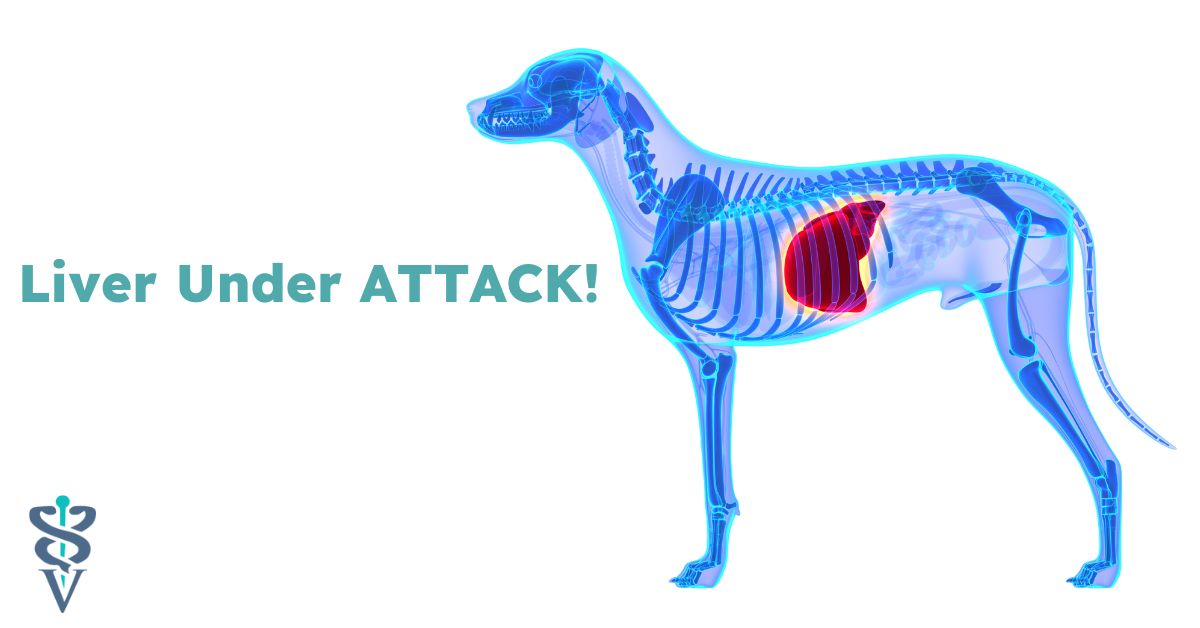
LIVER UNDER ATTACK!
By David Grant
I liked the summary notes of this veterinary webinar, with its eye- catching title by Amy Lam and it does give a flavour of what to expect in typical Australian enthusiastic style
‘Learn about one of the body’s most important organs in an hour, and what you can do for it. When should you worry about an increase in ALP or ALT? What are the synthetic biomarkers of the liver? Is there anything you can do to protect the liver? Is it too late? Let’s get nitty gritty with hepatic pathophysiology so you can help sick pets’
Amy expands on this in her first slide, which sets out the learning objectives:
· Why the liver is such an amazing organ
· Basic hepatic pathophysiology in the dog and cat
· The synthetic biomarkers of hepatic disease vs failure
· Common causes of liver disease in dogs and cats
· How to approach common (and uncommon) causes of liver disease -a practical approach
· Understand the treatments for liver disease and how they work
A major feature of this webinar is a large number of very detailed colourful slides of exceptional quality. In order to appreciate these and reflect upon them in RCVS fashion, it is best to photograph each slide and make some notes. To appreciate the webinar further I suggest viewing it in sections rather than in one session, as with questions and input from the sponsors it amounts to an hour and a half.
The first two slides summarise why the liver is essential to life with a detailed analysis of detoxification, metabolism, immune system, cholesterol production, storage of micronutrients, blood sugar balance, production of bile and protein synthesis. The liver has extraordinary powers of regeneration with figures given in days for various degrees of damage ranging from one third to 80-90%.
Late signs of liver dysfunction are listed -jaundice, hepatic encephalopathy, coagulopathies, ascites and hypoglycaemia.
Basic hepatic pathophysiology is explained via two beautifully drawn colour slides-camera out! This is followed by a detailed description of ALT and ALP and their use in deciding whether liver injury is caused by toxicity or cholestasis. For this you are introduced to the concept of R factors, and there is a good summary slide detailing some markers for differentiating cytotoxicity from cholestasis with ALT/ALP, Bilirubin, Cholesterol, PT, Bile acids and BUN/Urea.
Similarly, when discussing hepatic failure, Amy provides a line diagram with typical expected values for various biomarkers.
Jaundice, whether pre-hepatic, hepatic or post hepatic is explained by depicting bilirubin metabolism in another extraordinary multi- coloured diagram, followed by a description of bleeding disorders and a very detailed algorithm of hepatic failure.
Returning to the clinic there is a suggested format for approaching cases with liver disease. There is an excellent reminder of the importance of a very detailed history and thorough physical examination. Amy uses an Aide Memoire ‘DAMNIT V’ to cover the causes of hepatic damage, followed by the most detailed algorithm so far in this webinar for the investigation of jaundice. Another one to photograph and include in a practice protocol.
The final part of this section covers liver biopsy techniques and a table listing a bleeding assessment risk from liver biopsy.
The next part describes how to approach causes of liver disease in dogs beginning with hepatitis. Another algorithm takes you from liver biopsy to either lobular dissecting hepatitis, chronic hepatitis, cirrhosis or nonspecific reactive hepatopathy. A table lists possible causes for chronic hepatitis and whether the evidence is strong, moderate or weak. The next table lists seven factors supportive of chronic hepatitis.
Copper associated hepatitis, including its diagnosis and treatment is described before suggesting an approach to liver toxicity. Dose dependent hepatotoxicity and idiosyncratic hepatotoxicity are illustrated before Amy describes a clinical case of hepatic poisoning in a 3- year-old male neutered Maltese terrier.
The next section of the webinar deals with the treatment of toxic hepatic injury:
· Decontamination (if possible)
· Protect the liver
· Supportive care -hydration, electrolytes, nausea, pain, nutrition, and a comprehensive summary of hepatic protectants.
It’s back to biochemistry with descriptions of N-acetylcystine, S-adenylmethionine, Ursodeoxycholic acid, Silymarin, Vitamin E, and Omega 3 fatty acids. For inflammatory liver disease the following are discussed-prednisolone, cyclosporine, azathioprine and colchicine.
Finally, three further conditions are discussed. These are ascites, hepatic encephalopathy, and cholangiohepatopathy in cats.
This extensive webinar was generously sponsored by ADM (Protexin in the UK) and SASH vets. The company provided some of the latest information at the end of the webinar on selected products of relevance to Amy’s presentation. Included is Denamarin, Pro-Kolin, Cobalazorb, Pro-Kolin Enterogenic, Cysophan and CystoPro. There is a list, for colleagues watching in Australia or New Zealand, of company territory managers and their contact details.
I can’t begin to imagine how many hours Amy must have put in to produce this incredibly detailed webinar. Certainly, many more hours than the often quoted ten hours for a one hour presentation. To get the best out of it, as i have suggested, take notes and photograph the slides in 30 -minute sessions and then think about them before moving on to the next session. Many of the slides are very useful as protocols for investigations and treatments. The content will be of value for everyone in practice from newly qualified to experienced vets and nurses.
There was a further ten minutes for questions and these came on the night (early morning for Amy), from all parts of the globe. It’s quite astonishing how far we have come in recent times in technology with the ability to watch a live presentation in perfect sound and vision from anywhere in the world. It was a case of good morning, afternoon, evening or night wherever you from the chair Anthony Chadwick at the end.
